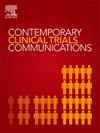Transmural collaborative care model for cardiovascular risk management and medication review in patients using antipsychotics in primary care (TACTIC): A study protocol of an incomplete stepped wedge cluster randomized trial
IF 1.4
Q4 MEDICINE, RESEARCH & EXPERIMENTAL
引用次数: 0
Abstract
Background
It is well established that patients with severe mental illness and those treated with atypical antipsychotics (AAPs) are at an increased risk of cardiovascular disease. However, primary care currently lacks adequate monitoring of AAP usage, its effects, and the associated cardiovascular risk. We have developed TACTIC, a transmural collaborative care model for patients using AAPs prescribed by the general practitioner (GP) to address the issues of potential overtreatment with AAPs and undertreatment for cardiovascular risk. TACTIC comprises three steps: an informative video for patients, a multidisciplinary meeting, and a shared decision-making consultation with the GP.
Objectives
To evaluate TACTIC's effectiveness on cardiovascular risk and mental health and its cost-effectiveness.
Methods
We will conduct an incomplete stepped wedge cluster randomized trial in the Netherlands.
40 GP-nurse clusters are randomized into four waves. Each cluster recruits adult patients (25–85 years), without prior diagnoses of dementia, delirium, or cardiovascular disease, for whom the GP prescribes AAPs. Every five months, a new wave starts with TACTIC. Measurements are taken before the intervention starts and every 5 months until the study concludes. Primary outcomes are cardiovascular risk and mental health as measured with the QRISK3 score and MHI5, respectively. The economic evaluation consists of two cost-utility analyses, one on the data collected alongside the trial and one based on a model extrapolating the trial data to a 10-year horizon. We will also evaluate the process of delivering TACTIC.
Conclusion
This study will assess TACTIC's (cost)effectiveness and provide insights for successful delivery in general practice.
Clinical trials registration
clinicaltrials.gov NCT05647980.
在初级保健中使用抗精神病药物的患者的心血管风险管理和药物回顾的跨壁协作护理模型(战术):一项不完全阶梯楔形聚类随机试验的研究方案。
背景:重度精神疾病患者和接受非典型抗精神病药物(AAPs)治疗的患者发生心血管疾病的风险增加。然而,初级保健目前缺乏对AAP使用、其影响和相关心血管风险的充分监测。我们开发了一种战术,一种全科医生(GP)开具aap处方的患者的跨壁协作护理模式,以解决潜在的aap过度治疗和心血管风险治疗不足的问题。策略包括三个步骤:为患者提供信息视频,多学科会议,以及与全科医生共同决策咨询。目的:评价策略对心血管风险和心理健康的影响及其成本-效果。方法:我们将在荷兰进行一项不完全阶梯楔形随机分组试验,将40个gp护士分组随机分为四组。每组招募成人患者(25-85岁),既往无痴呆、谵妄或心血管疾病诊断,由全科医生开具AAPs处方。每隔五个月,就会有一波新的战术浪潮开始。测量在干预开始前进行,每5个月进行一次,直到研究结束。主要结局是心血管风险和心理健康,分别用QRISK3评分和MHI5来衡量。经济评价包括两项成本效用分析,一项是根据与试验同时收集的数据,另一项是根据将试验数据外推至10年的模型。我们还将评估交付战术的过程。结论:本研究将评估策略的(成本)有效性,并为在一般实践中成功交付提供见解。临床试验注册:clinicaltrials.gov NCT05647980。
本文章由计算机程序翻译,如有差异,请以英文原文为准。
求助全文
约1分钟内获得全文
求助全文
来源期刊

Contemporary Clinical Trials Communications
Pharmacology, Toxicology and Pharmaceutics-Pharmacology
CiteScore
2.70
自引率
6.70%
发文量
146
审稿时长
20 weeks
期刊介绍:
Contemporary Clinical Trials Communications is an international peer reviewed open access journal that publishes articles pertaining to all aspects of clinical trials, including, but not limited to, design, conduct, analysis, regulation and ethics. Manuscripts submitted should appeal to a readership drawn from a wide range of disciplines including medicine, life science, pharmaceutical science, biostatistics, epidemiology, computer science, management science, behavioral science, and bioethics. Contemporary Clinical Trials Communications is unique in that it is outside the confines of disease specifications, and it strives to increase the transparency of medical research and reduce publication bias by publishing scientifically valid original research findings irrespective of their perceived importance, significance or impact. Both randomized and non-randomized trials are within the scope of the Journal. Some common topics include trial design rationale and methods, operational methodologies and challenges, and positive and negative trial results. In addition to original research, the Journal also welcomes other types of communications including, but are not limited to, methodology reviews, perspectives and discussions. Through timely dissemination of advances in clinical trials, the goal of Contemporary Clinical Trials Communications is to serve as a platform to enhance the communication and collaboration within the global clinical trials community that ultimately advances this field of research for the benefit of patients.
 求助内容:
求助内容: 应助结果提醒方式:
应助结果提醒方式:


